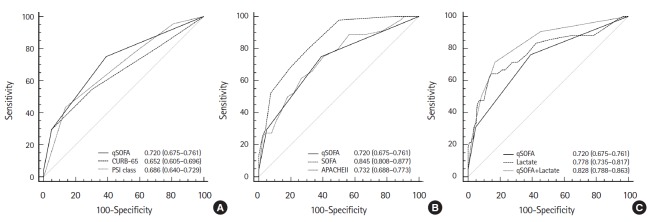Fig. 3.
The receiver operating characteristic curves for in-hospital mortality relative to the predictive power of various scoring systems. (A) The ability to predict in-hospital mortality was higher when the quick Sequential Organ Failure Assessment (qSOFA) was used rather than either the confusion, urea, respiratory rate, blood pressure, and age (CURB-65) or Pneumonia Severity Index (PSI). However, these differences were not statistically significant. (B) When the discrimination between survivors and non-survivors were compared, the qSOFA scores were slightly lower than the Acute Physiology and Chronic Health Evaluation (APACHE) II score and Sequential Organ Failure Assessment (SOFA) score. (C) The ability of qSOFA with lactate concentrations in predicting hospital mortality was significantly higher than that of qSOFA alone or lactate alone.

